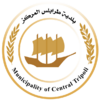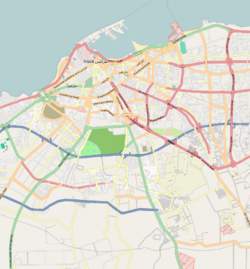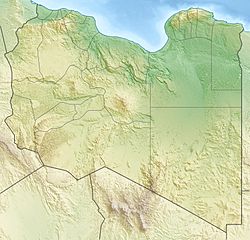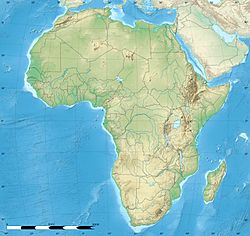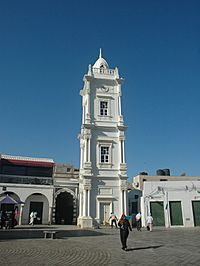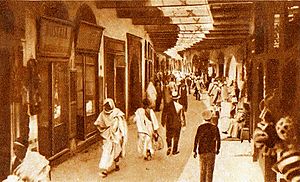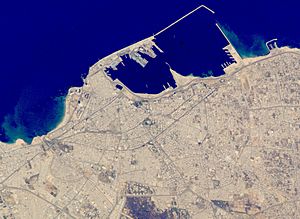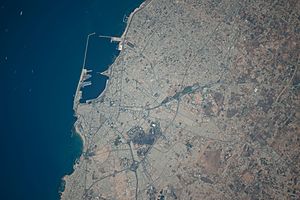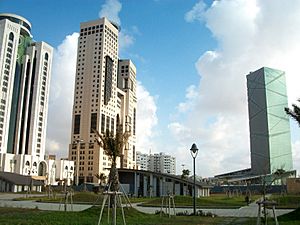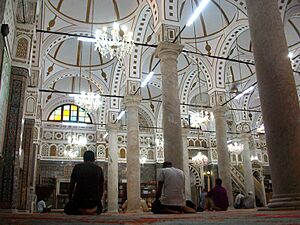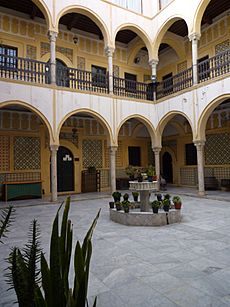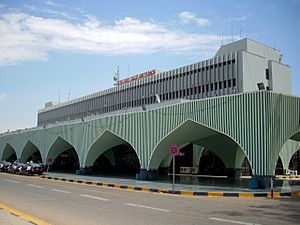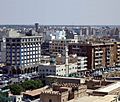Tripoli, Libya facts for kids
Quick facts for kids
Tripoli
طرابلس
|
|||
|---|---|---|---|
|
Clockwise from top: Tripoli panorama; Tripoli Central Business District; Arch of Marcus Aurelius; a street in Tripoli; Tripoli Beach Park; Martyrs' Square; and Red Castle Museum
|
|||
|
|||
|
OpenStreetMap
Location in Libya
|
|||
| Country | Libya | ||
| Region | Tripolitania | ||
| District | Tripoli District | ||
| First settled | 7th century BC | ||
| Founded by | Phoenicians | ||
| Area | |||
| • Capital city | 1,507 km2 (582 sq mi) | ||
| Elevation | 81 m (266 ft) | ||
| Population
(2023)
|
|||
| • Capital city | 1,183,000 | ||
| • Urban | 1,176,296 | ||
| • Metro | 1,192,436 | ||
| Time zone | UTC+2 (EET) | ||
| Area code(s) | 21 | ||
| License Plate Code | 5 | ||
| Website | tlc.gov.ly (archived) | ||
Tripoli is the capital and largest city of Libya. It is home to about 1.3 million people. The city is located in northwest Libya, right on the edge of the desert. It sits on a rocky piece of land that sticks out into the Mediterranean Sea, forming a bay.
Tripoli has a busy port and is a major center for business and manufacturing in Libya. It is also where the University of Tripoli is located. The city was founded a very long time ago, in the 7th century BC, by the Phoenicians. They gave it the name Oyat. Later, it was called Oea by Greek rulers. Because of its long history, Tripoli has many important old sites. The name "Tripoli" can also refer to the larger area around the city, known as the Tripoli District.
Contents
What's in a Name?
In the Arab world, Tripoli is sometimes called Tripoli-of-the-West. This helps tell it apart from Tripoli, Lebanon, which is known as 'Tripoli of the East'. People also lovingly call Tripoli "The Mermaid of the Mediterranean." This name describes its beautiful blue waters and white buildings.
The name "Tripoli" comes from a Greek word, Tripolis, which means "three cities". This refers to three ancient cities: Oea (which is modern Tripoli), Sabratha, and Leptis Magna. Oea was the only one of these three cities that continued to exist through history. It then became known as Tripoli.
Tripoli's Long History
Early Beginnings: Oea and Tripolitania
The city of Tripoli was started in the 7th century BC by the Phoenicians. They called it Oyat. It's thought that the city might have been built on an older native Berber settlement. The Phoenicians likely chose this spot because it had a good natural harbor. They built their colony on a small, easy-to-defend peninsula.
Later, the city was taken over by Greek rulers from Cyrenaica and was called Oea. After that, the Carthaginians took control from the Greeks.
By the late 2nd century BC, the city belonged to the Romans. They included it in their province of Africa. Around the early 3rd century AD, it became known as the Regio Tripolitana. This means "region of the three cities," referring to Oea (Tripoli), Sabratha, and Leptis Magna.
Even after hundreds of years of Roman rule, there aren't many Roman ruins left in Tripoli. The most visible one is the Arch of Marcus Aurelius from the 2nd century AD. Because people have lived in Tripoli continuously, they often used materials from older buildings or built new structures on top of them. This means many ancient Roman sites are still buried under the city streets.
In the 7th century AD, Muslim forces took control of Tripoli. After this, Tripoli was ruled by different dynasties from Cairo, Egypt, and Kairouan in Ifriqiya (North Africa).
From Knights to Ottomans (16th-19th Centuries)

In 1510, Spain conquered Tripoli. Then, in 1530, the city was given to the Knights of St. John. These Knights had been forced out of their home on the island of Rhodes by the Ottoman Turks. The Knights strengthened the city walls and built new defenses. Many of the oldest parts of the Tripoli castle, also known as the "Red Castle," were built by these Knights.
The Knights were given charge of Tripoli to stop Barbary pirates from taking it over again. These pirates caused a lot of trouble for ships in the Mediterranean Sea.
In 1551, the Ottomans captured Tripoli after a siege, led by the Turkish commander Turgut Reis. Turgut Reis became the pasha (governor) of Tripoli. He improved the city, making it one of the most impressive along the North African coast. He was buried in Tripoli after his death in 1565. His tomb is still there, near the Sidi Darghut Mosque.
After the Ottomans took over, Tripoli again became a base for Barbary pirates. In 1711, a Janissary officer named Ahmed Karamanli took control of the region. He created the Karamanli dynasty, which ruled Tripoli as a semi-independent kingdom until 1835. During this time, piracy continued. In 1835, the Ottoman Empire took back direct control of Tripoli.
Barbary Wars (1801-1815)
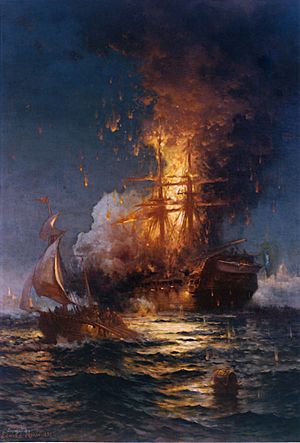
In the early 1800s, Tripoli was involved in two wars with the United States because of its pirating activities. In 1801, the pasha of Tripoli demanded more money from the U.S. government to protect their ships from pirates. President Thomas Jefferson refused, and the U.S. sent a naval force to blockade Tripoli.
The First Barbary War (1801–1805) lasted four years. In 1803, Tripolitan fighters captured the U.S. Navy ship Philadelphia. Its commander and crew were taken prisoner. The Philadelphia was later burned by U.S. Navy Lieutenant Stephen Decatur in a daring nighttime raid to prevent it from being used by the enemy.
The war ended in 1805 with a peace treaty. The pasha stopped his demands and received money for the release of the Philadelphia prisoners. In 1815, American forces visited Tripoli again and made the pasha agree to their demands, ending the Second Barbary War.
Italian Rule (1912-1947)
Italy believed Tripoli was part of its area of influence. In 1911, Italy declared war on the Ottomans and planned to take over Tripoli. By the Treaty of Lausanne, Italy gained control of Tripoli and the surrounding region.
Under Italian rule, Tripoli saw many improvements. In the early 1920s, a sewage system and a modern hospital were built. A major road, the Litoranea Balbia, was built along the coast in 1937–1938.
In 1927, the Italians started the Tripoli International Fair to boost the city's economy. This is the oldest trade fair in Africa. They also created the Tripoli Grand Prix, an international car race that ran until 1940. The first airport in Libya, the Mellaha Air Base, was built near Tripoli in 1923. Today, it's called Mitiga International Airport.
Tripoli was controlled by Italy until 1943, when British forces captured it during World War II. The city was then governed by the British until Libya became independent in 1951.
Recent Times (1969-Present)
In 1969, Colonel Muammar Gaddafi became the leader of Libya. In 1986, the United States carried out air strikes on Tripoli and Benghazi. This was in response to a bombing in West Berlin.
In 2003, the United Nations lifted sanctions against Libya. This helped Tripoli's economy, increasing trade through its port and airports.
In 2011, Tripoli experienced protests and conflict during the Libyan Civil War. The city's Green Square (later renamed Martyrs' Square by rebels) became a key location for these events. Rebel forces eventually took control of Tripoli in August 2011.
The city has continued to face challenges, with further clashes in 2022 and 2023.
Tripoli's Geography
Tripoli is located in the very west of Libya, near the border with Tunisia. It is over 1,000 kilometers (621 miles) away from Libya's second-largest city, Benghazi. Along the coast of Tripolitania, you'll find oases mixed with sandy areas and lagoons. The city is about 70 kilometers north of the Nafusa Mountains, which are the source of seasonal rivers.
Climate and Water
Tripoli has a hot semi-arid climate. This means it has long, hot, and dry summers, and mild, relatively wet winters. Summers are often hot and humid, with temperatures sometimes going above 38°C (100°F). In winter, temperatures can drop to 0°C (32°F), but usually stay between 9°C (48°F) and 18°C (64°F). The city receives less than 400 millimeters (16 inches) of rain each year. Snowfall is very rare but has happened.
Rainfall can be unpredictable. In 1945, floods covered Tripoli for several days. But just two years later, a severe drought caused many animals to die. Because there are no permanent rivers in Tripoli or the rest of the country, water is very important. The Great Manmade River, a huge network of pipelines, brings water from the desert to coastal cities like Tripoli. This project was started in 1982.
Martyrs' Square, near the waterfront, is filled with palm trees. The Tripoli Zoo, south of the city center, was once Libya's largest zoo. It faced difficulties during the 2011 civil war but is slowly recovering.
| Climate data for Tripoli (1961–1990, extremes 1944–1993) | |||||||||||||
|---|---|---|---|---|---|---|---|---|---|---|---|---|---|
| Month | Jan | Feb | Mar | Apr | May | Jun | Jul | Aug | Sep | Oct | Nov | Dec | Year |
| Record high °C (°F) | 32.2 (90.0) |
35.3 (95.5) |
40.0 (104.0) |
42.2 (108.0) |
45.6 (114.1) |
47.8 (118.0) |
48.3 (118.9) |
48.3 (118.9) |
47.2 (117.0) |
42.2 (108.0) |
37.2 (99.0) |
31.1 (88.0) |
48.3 (118.9) |
| Mean daily maximum °C (°F) | 16.4 (61.5) |
18.5 (65.3) |
20.7 (69.3) |
23.7 (74.7) |
27.1 (80.8) |
30.4 (86.7) |
31.7 (89.1) |
32.6 (90.7) |
31.0 (87.8) |
26.5 (79.7) |
23.0 (73.4) |
18.7 (65.7) |
25.0 (77.1) |
| Daily mean °C (°F) | 12.7 (54.9) |
13.9 (57.0) |
15.3 (59.5) |
18.7 (65.7) |
21.9 (71.4) |
25.3 (77.5) |
26.7 (80.1) |
27.7 (81.9) |
26.2 (79.2) |
21.5 (70.7) |
16.8 (62.2) |
13.9 (57.0) |
20.1 (68.1) |
| Mean daily minimum °C (°F) | 8.0 (46.4) |
9.1 (48.4) |
10.5 (50.9) |
13.7 (56.7) |
16.7 (62.1) |
20.1 (68.2) |
21.7 (71.1) |
22.7 (72.9) |
21.4 (70.5) |
17.6 (63.7) |
12.5 (54.5) |
9.3 (48.7) |
15.3 (59.5) |
| Record low °C (°F) | −0.6 (30.9) |
−0.6 (30.9) |
0.6 (33.1) |
2.8 (37.0) |
5.0 (41.0) |
10.0 (50.0) |
12.2 (54.0) |
13.9 (57.0) |
11.8 (53.2) |
6.6 (43.9) |
1.1 (34.0) |
−1.3 (29.7) |
−1.3 (29.7) |
| Average rainfall mm (inches) | 62.1 (2.44) |
32.2 (1.27) |
29.6 (1.17) |
14.3 (0.56) |
4.6 (0.18) |
1.3 (0.05) |
0.7 (0.03) |
0.1 (0.00) |
16.7 (0.66) |
46.6 (1.83) |
58.2 (2.29) |
67.5 (2.66) |
333.9 (13.15) |
| Average rainy days (≥ 0.1 mm) | 9.4 | 6.4 | 5.8 | 3.3 | 1.5 | 0.6 | 0.2 | 0.0 | 2.3 | 6.8 | 6.9 | 9.1 | 57.4 |
| Average relative humidity (%) | 66 | 61 | 58 | 55 | 53 | 49 | 49 | 51 | 57 | 60 | 61 | 65 | 57 |
| Mean monthly sunshine hours | 170.5 | 189.3 | 226.3 | 255.0 | 306.9 | 297.0 | 356.5 | 337.9 | 258.0 | 226.3 | 186.0 | 164.3 | 2,974 |
| Mean daily sunshine hours | 5.5 | 6.7 | 7.3 | 8.5 | 9.9 | 9.9 | 11.5 | 10.9 | 8.6 | 7.3 | 6.2 | 5.3 | 8.1 |
| Source 1: World Meteorological Organization | |||||||||||||
| Source 2: Deutscher Wetterdienst (extremes and humidity), Arab Meteorology Book (sun only) | |||||||||||||
Tripoli's Economy
Tripoli is a major economic center in Libya. It is a leading hub for banking, finance, and communication. Many large companies in Libya have their main offices in Tripoli, as do most international companies.
Important goods made in Tripoli include processed food, textiles, building materials, clothing, and tobacco products. Since international sanctions were lifted in 1999 and 2003, Tripoli has seen more foreign investment and a rise in tourism. The city's port and Tripoli International Airport have also seen increased activity.
The city hosts the Tripoli International Fair, a yearly event for industry, agriculture, and business. It takes place from April 2nd to 12th. Around 30 countries and over 2,000 companies usually participate.
With more tourism, there's been a greater need for hotels. The Corinthia Bab Africa Hotel, built in 2003, is the largest hotel in Libya. Other top hotels include the Al Waddan Intercontinental and the Tripoli Radisson Blu Hotel.
Several airlines have their main offices in Tripoli, such as Afriqiyah Airways and Libyan Airlines. Buraq Air is based at Mitiga International Airport.
Architecture and Landmarks
Tripoli's old town, called the Medina, mostly looks as it does today because of the Ottoman period (from the 16th century onwards). You can find many old Roman columns reused in different historic buildings throughout the city.
The city walls have been rebuilt and changed many times over the centuries. Their final shape, which gives the Medina its pentagonal layout, comes from the 16th century when the Ottomans made the town stronger.
The oldest Islamic building in Tripoli is the al-Naqah Mosque. It was likely first built in 973. Most other mosques in the city today were built or rebuilt during the Ottoman era. They often have many domes supported by columns. The largest ones include the Mosque of Darghut Pasha (finished in 1556) and the Mosque of Ahmad Pasha al-Karamanli (finished around 1738). These mosques often have other buildings like schools (madrasas), bathhouses, and markets nearby.
The Medina also has old inns called funduqs (caravanserais) from the Ottoman period. These are usually two-story buildings around a courtyard. The first floor was for storage, and the second floor had shops. Historic houses in the city are similar, with multiple stories and an inner courtyard.
A clock tower, 18 meters (59 feet) tall, was built between 1866 and 1870 by the Ottoman governor. It is still a well-known landmark in the city.
During Italian rule, many buildings were constructed in an Italianate style. These include the Galleria De Bono. The Tripoli Cathedral was also built then, but it is now a mosque. Some Italian-built structures, like the Royal Miramare Theatre and the Tripoli Railway Central Station, were later removed.
Culture and Places to Visit
The Red Castle of Tripoli (Assaraya al-Hamra) is a large palace complex that stands out in the city. It has many courtyards and is located at the edge of the Medina. The castle is home to the Red Castle Museum, where you can learn about the city's history.
For places of worship, Tripoli has many Muslim mosques. There are also Christian churches, including those for the Catholic Church, Coptic Orthodox Church, and various Protestant churches.
Education in Tripoli
The largest university in Tripoli is the University of Tripoli, a public university that offers free education. In recent years, private universities and colleges have also opened in the city.
There are several international schools in Tripoli, including:
- Trafalgar International School Tripoli
- Lycée Français de Tripoli
- Deutsche Schule Tripolis
- Scuola Italiana Al Maziri
- Russian Embassy School in Tripoli
- British School Tripoli
- American School of Tripoli
- ISM International School
- Ladybird International School
- Tripoli International School
- Tripoli World Academy
- Global Knowledge School
- مدرسة المعرفة الدولية السراج
Sports in Tripoli
Football is the most popular sport in Tripoli. The city is home to major football clubs like Al Madina, Al Ahly Tripoli, and Al-Ittihad Tripoli. Other sports clubs include Al Wahda Tripoli and Addahra.
Tripoli also hosted the Italian Super Cup in 2002. The city was planned to host games for the 2017 Africa Cup of Nations, but this was canceled due to ongoing conflict. In 2009, Tripoli hosted the final games of the official 2009 African Basketball Championship.
Transportation
Two major trans-African roads pass through Tripoli:
- Cairo-Dakar Highway
- Tripoli-Cape Town Highway
Tripoli International Airport was the city's largest airport. However, it was damaged during the second Libyan civil war in 2014. Since then, Tripoli has been served by a smaller airport, Mitiga International Airport, which is now the largest in Libya.
Reconstruction efforts are underway to rebuild the damaged airport facilities. All flights have been moved to Mitiga International Airport since 2017.
Tripoli is also the planned destination for a railway line from Sirte, which was under construction in 2007.
Images for kids
-
The old Tripoli Cathedral (now a mosque) and the former FIAT center (Algeria Square) in the 1960s.
International Connections
Tripoli has "sister city" relationships with:
- Baltimore, United States
- Belgrade, Serbia
- Belo Horizonte, Brazil (2003)
- Madrid, Spain
- Sarajevo, Bosnia and Herzegovina (1976)
See also
 In Spanish: Trípoli para niños
In Spanish: Trípoli para niños











